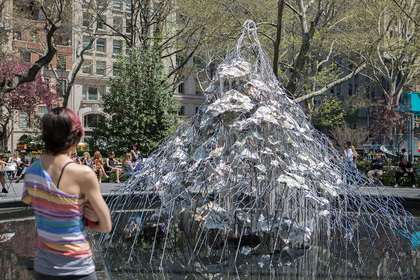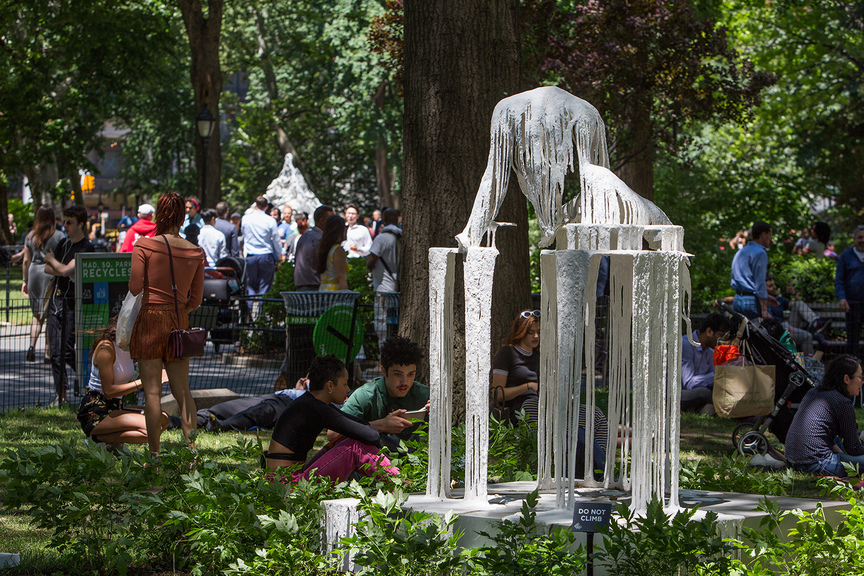-
From Current Issue
-
- Editor’s Letter Fire in the Heart
- Reviews I Gusti Ayu Kadek Murniasih
- Reviews 11th Seoul Mediacity Biennale: “One Escape at a Time”
- Dispatch Networked China
- One on One Monira Al Qadiri on Yukio Mishima
- Essays The rise of independent art spaces in pandemic-era Shanghai
- Features Tuan Andrew Nguyen
- Table of Contents
- Web Exclusives
- Archive
- Subscribe

R
E
V N
E
X
T
Installation view of DIANA AL-HADID’s (foreground) The Grotto, 2017–18, aluminum, steel, polymer gypsum, fiberglass, and pigment, 11 × 4.2 × 0.3 m; and (background) Gradiva, 2017–18, aluminum, steel, polymer gypsum, fiberglass, and pigment, 4.6 × 4 × 0.3 m, at “Delirious Matter,” Madison Square Park, New York, 2018. Photo Rashmi Gill. All images courtesy the artist and Marianne Boesky Gallery, New York.
Born in Aleppo, Syria, in 1981, American artist Diana al-Hadid immigrated as a five-year-old child to the United States, where she grew up in an Arabic-speaking Muslim household in the suburbs of Ohio. Now based in Brooklyn, al-Hadid is known for her architectural structures that seem to dissolve in space, painstakingly created by applying such common construction materials as polymer gypsum, fiberglass and pigment by hand, intuitively building the sculptures bit by bit until her vision is realized. Her public art exhibition, “Delirious Matter,” which features six new sculptures from 2017–18, imaginatively transforms the green space of New York’s Madison Square Park into a spectacular site for creative contemplation.
Resembling melting forms and architectural ruins, al-Hadid’s sculptures are made by the controlled dripping of polymer gypsum on walls (the lace-like panels are then peeled off to become freestanding works), as well as on three-dimensional armatures that provide structural supports for abstract compositions and symbolic figures. In Madison Square Park, three sculptures of reclining female figures on disappearing pedestals and a woman growing out of a mountain in a reflective pond surround two facing, wall-like structures that are framed with hedgerows in the center of an oval lawn.
Installation view of DIANA AL-HADID’s (foreground) The Grotto, 2017–18, aluminum, steel, polymer gypsum, fiberglass, and pigment, 11 × 4.2 × 0.3 m; and (background) Gradiva, 2017–18, aluminum, steel, polymer gypsum, fiberglass, and pigment, 4.6 × 4 × 0.3 m, at “Delirious Matter,” Madison Square Park, New York, 2018. Photo Object Studies.
The facing wall works, titled The Grotto and Gradiva, measure 11 and 4.6 meters wide respectively and are the largest pieces in the exhibition. Blurring the boundary between painting and sculpture, the perforated pieces began as drips, growing dimensionally off the wall they were built upon before being peeled off and reinforced with fiberglass and steel for placement outdoors.
The Grotto appears to recreate the opening of a cave in a flattened form. The drips create stalactites, and leave gaps that make it look as though the edifice is deteriorating, imbuing the grotto with a primordial aesthetic. A series of black mountains are painted onto the white surface, with the bust of a roughly sketched female figure faintly popping out of the highest peak, which is a reference to Hans Memling’s Renaissance painting, Allegory of Chastity (circa 1475).
Installation view of DIANA AL-HADID’s Gradiva, 2017–18, aluminum, steel, polymer gypsum, fiberglass, and pigment, 4.6 × 4 × 0.3 m, at “Delirious Matter,” Madison Square Park, New York, 2018. Photo Rashmi Gill.
Likewise, Gradiva offers a porous, wall-like sculpture that rises from the ground to a four-meter-high leveled peak. The swirling mass of lines that form the structure, some of which are painted in gray, green and blue, give the illusion of a walking female figure (“gradiva” is “she who walks” in Latin)—a reference to Wilhelm Jensen’s 1902 German novella Gradiva, which relates an archaeologist’s fixation on a Roman bas-relief of a strident woman in a flowing gown, and which was later analyzed by Sigmund Freud. Four vertical bands of black painted lines reinforce the monumental nature of the piece, while painted areas of pale blue, which are interspersed across the surface, and the rising realm of the gypsum elements give the feeling of a fountain in motion.
Citadel, a mountainous form that climbs four meters up from a reflective pond, equally looks like a fountain from a distance, yet more like a figure in a big dress when viewed up close. Another interpretation of Memling’s Allegory of Chastity, the sculpture has an exposed armature, created from a network of interlocking metal rods, that is analytically coated with areas of gypsum to simulate a series of snow-capped peaks. Poking out of the mountaintop, an abstracted female figure nobly gazes down upon the park’s visitors, passing by or resting below.
Rounding out the open-air exhibition are three similar sculptures of a headless woman in a reclining pose, resting atop a pedestal that seems to dissipate before our eyes. Lined up on an axis that wraps around the outer realm of the park, the three white works—all titled Synonym—face inward to the central pieces on the oval green. Different versions of an edition cast after the artist’s 2012 sculpture Antonym, which has a similar yet less fragmented form, they add another female subject to the show’s mix. While Gradiva portrays a fleeting woman and The Grotto and Citadel reveal a stable one, Synonym depicts a disintegrating, empty shell of a figure, in which the drips composing its form flow into puddles on the plinth below—an apt metaphor for how the artist highlights her elusive process over the appearance of solid matter.
Paul Laster is a New York desk editor for ArtAsiaPacific.
Diana al-Hadid’s “Delirious Matter” is on view at Madison Square Park, New York, until September 3, 2018.
To read more of ArtAsiaPacific’s articles, visit our Digital Library.







